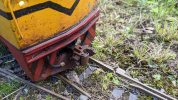Just beware that in your efforts to get a level section before the curve, you do not increase the gradient too much..
I personally think that gradients do not really 'scale' well, with the other limitations of our stock and track geometry. Less is better, but we are often constrained by the prevailing conditions.
PhilP
I personally think that gradients do not really 'scale' well, with the other limitations of our stock and track geometry. Less is better, but we are often constrained by the prevailing conditions.
PhilP



